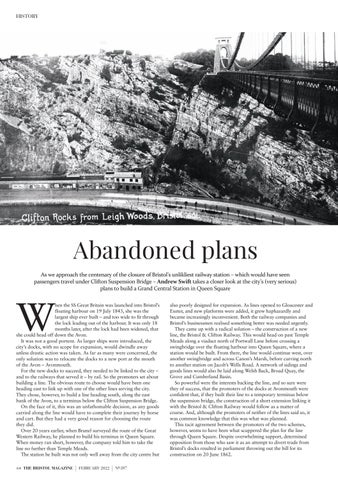ANDREW SWIFT – FEB.qxp_Layout 2 21/01/2022 17:09 Page 1
HISTORY
Abandoned plans As we approach the centenary of the closure of Bristol’s unlikliest railway station – which would have seen passengers travel under Clifton Suspension Bridge – Andrew Swift takes a closer look at the city’s (very serious) plans to build a Grand Central Station in Queen Square
W
hen the SS Great Britain was launched into Bristol’s floating harbour on 19 July 1843, she was the largest ship ever built – and too wide to fit through the lock leading out of the harbour. It was only 18 months later, after the lock had been widened, that she could head off down the Avon. It was not a good portent. As larger ships were introduced, the city’s docks, with no scope for expansion, would dwindle away unless drastic action was taken. As far as many were concerned, the only solution was to relocate the docks to a new port at the mouth of the Avon – Avonmouth. For the new docks to succeed, they needed to be linked to the city – and to the railways that served it – by rail. So the promoters set about building a line. The obvious route to choose would have been one heading east to link up with one of the other lines serving the city. They chose, however, to build a line heading south, along the east bank of the Avon, to a terminus below the Clifton Suspension Bridge. On the face of it, this was an unfathomable decision, as any goods carried along the line would have to complete their journey by horse and cart. But they had a very good reason for choosing the route they did. Over 20 years earlier, when Brunel surveyed the route of the Great Western Railway, he planned to build his terminus in Queen Square. When money ran short, however, the company told him to take the line no further than Temple Meads. The station he built was not only well away from the city centre but 64 THE BRISTOL MAGAZINE
|
FEBRUARY 2022
|
NO¯ 207
also poorly designed for expansion. As lines opened to Gloucester and Exeter, and new platforms were added, it grew haphazardly and became increasingly inconvenient. Both the railway companies and Bristol’s businessmen realised something better was needed urgently. They came up with a radical solution – the construction of a new line, the Bristol & Clifton Railway. This would head on past Temple Meads along a viaduct north of Portwall Lane before crossing a swingbridge over the floating harbour into Queen Square, where a station would be built. From there, the line would continue west, over another swingbridge and across Canon’s Marsh, before curving north to another station on Jacob’s Wells Road. A network of sidings and goods lines would also be laid along Welsh Back, Broad Quay, the Grove and Cumberland Basin. So powerful were the interests backing the line, and so sure were they of success, that the promoters of the docks at Avonmouth were confident that, if they built their line to a temporary terminus below the suspension bridge, the construction of a short extension linking it with the Bristol & Clifton Railway would follow as a matter of course. And, although the promoters of neither of the lines said so, it was common knowledge that this was what was planned. This tacit agreement between the promoters of the two schemes, however, seems to have been what scuppered the plan for the line through Queen Square. Despite overwhelming support, determined opposition from those who saw it as an attempt to divert trade from Bristol’s docks resulted in parliament throwing out the bill for its construction on 20 June 1862.
















